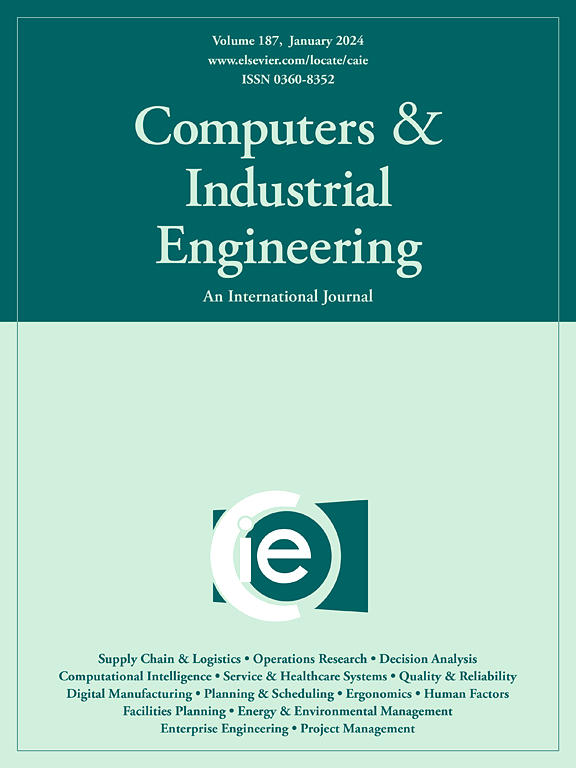Deep-Q-network-enhanced aquila-equilibrium hyper-heuristic algorithm for preventive maintenance integrated disassembly line balancing involving worker redeployment
IF 6.7
1区 工程技术
Q1 COMPUTER SCIENCE, INTERDISCIPLINARY APPLICATIONS
引用次数: 0
Abstract
The increasing production and replacement rates of modern commodities demand efficient recovery of end-of-life (EOL) products. This study promotes green and sustainable remanufacturing by investigating semi-automated disassembly lines. Preventive maintenance (PM), rarely studied in disassembly lines, is integrated with the line balancing problem and worker redeployment scheduling to construct a stable and reliable disassembly process. Additionally, this study considers the diversity of disassembly robots in PM scheduling, including their operating speed, energy consumption, and maintenance requirements, to enhance line efficiency and reduce carbon emissions. A mixed-integer programming model is proposed for the Preventive Maintenance-integrated Semi-Automated Disassembly Line Balancing Problem (PM-SADLBP), and is verified by an exact Epsilon-Constraint method. To solve this NP-hard problem, a Deep-Q-Network-enhanced Aquila-Equilibrium Hyper-Heuristic algorithm (DN-AEHH) is developed. A Hybrid Adaptive-length Triple-layer Real Encoding Approach and Self-repairing Decoding Mechanism are tailored to create an effective mapping between continuous solution space and discrete balancing and scheduling plans. Numerical experiments demonstrate that DN-AEHH outperforms five state-of-the-art algorithms across multiple problem scales, with a dominant rate of 83.01%. Additionally, managerial application shows 7.72% improvement in energy efficiency and 36.04% reduction in weighted cycle time with DN-AEHH to optimize PM. These findings provide practical guidance for line establishment and maintenance, supporting decision-making for managers with diverse preferences and operational contexts.
涉及工人重新部署的预防性维护集成拆解线平衡的深度q网络增强aquila-equilibrium超启发式算法
随着现代商品生产和更新率的提高,对报废产品的有效回收提出了要求。本研究透过调查半自动化拆解生产线,促进绿色与永续再制造。将装配线的预防性维护与生产线平衡问题和工人重新部署调度相结合,构建一个稳定可靠的拆卸过程,这是装配线中很少研究的问题。此外,本研究还考虑了拆卸机器人在PM调度中的多样性,包括其操作速度,能耗和维护要求,以提高生产线效率并减少碳排放。针对预防性维修集成式半自动拆装线平衡问题,提出了一种混合整数规划模型,并用精确的epsilon约束方法进行了验证。为了解决这一NP-hard问题,提出了一种deep - q - network增强型Aquila-Equilibrium超启发式算法(DN-AEHH)。为了在连续解空间和离散平衡调度计划之间建立有效的映射关系,设计了一种混合自适应长度三层实编码方法和自修复解码机制。数值实验表明,在多个问题尺度上,DN-AEHH优于5种最先进的算法,优势率为83.01%。此外,管理应用表明,DN-AEHH优化PM的能源效率提高了7.72%,加权周期时间减少了36.04%。这些发现为生产线的建立和维护提供了实用的指导,支持具有不同偏好和操作环境的管理人员的决策。
本文章由计算机程序翻译,如有差异,请以英文原文为准。
求助全文
约1分钟内获得全文
求助全文
来源期刊

Computers & Industrial Engineering
工程技术-工程:工业
CiteScore
12.70
自引率
12.70%
发文量
794
审稿时长
10.6 months
期刊介绍:
Computers & Industrial Engineering (CAIE) is dedicated to researchers, educators, and practitioners in industrial engineering and related fields. Pioneering the integration of computers in research, education, and practice, industrial engineering has evolved to make computers and electronic communication integral to its domain. CAIE publishes original contributions focusing on the development of novel computerized methodologies to address industrial engineering problems. It also highlights the applications of these methodologies to issues within the broader industrial engineering and associated communities. The journal actively encourages submissions that push the boundaries of fundamental theories and concepts in industrial engineering techniques.
 求助内容:
求助内容: 应助结果提醒方式:
应助结果提醒方式:


